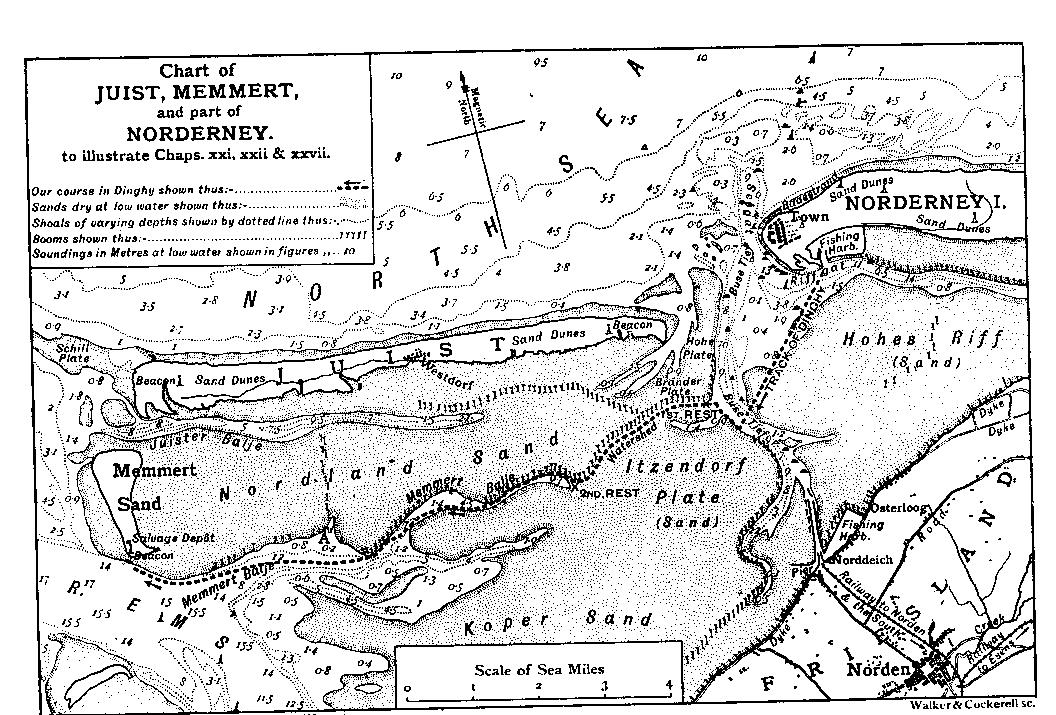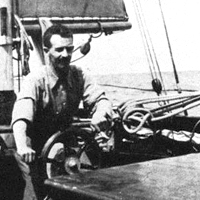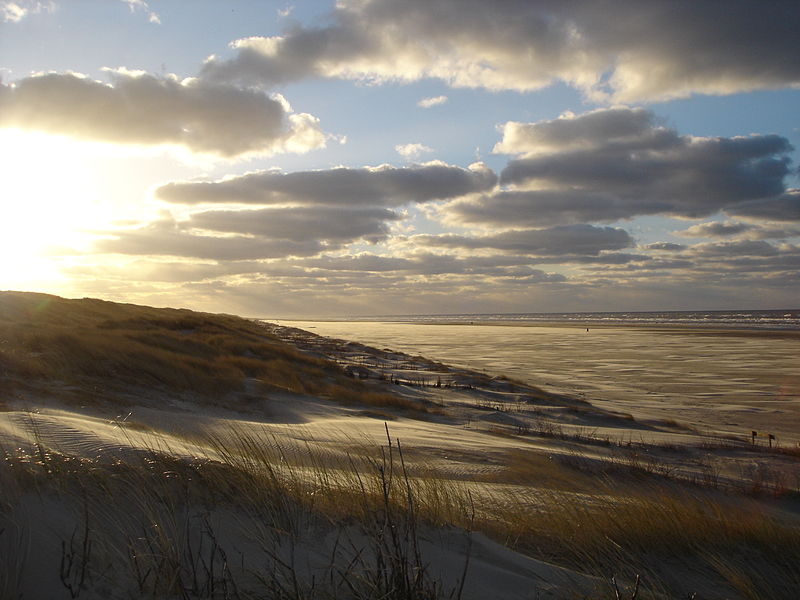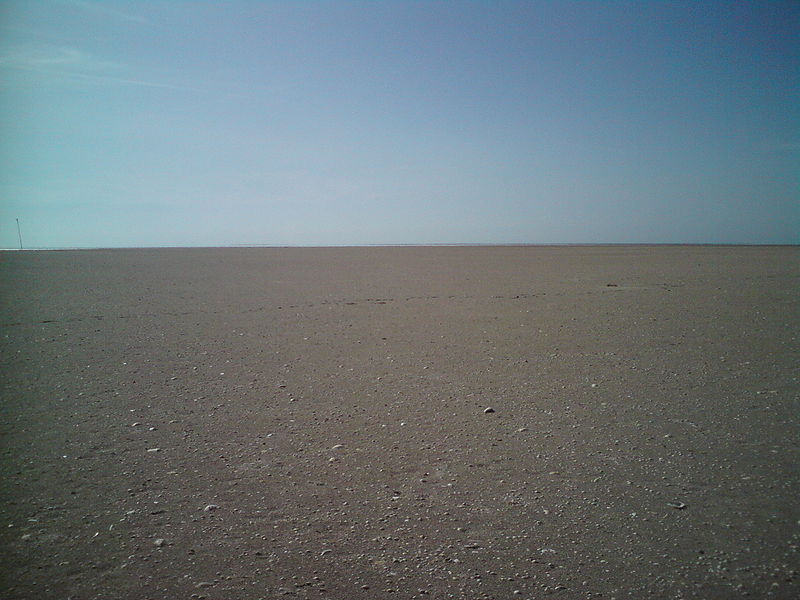We had an old copy of The Riddle of the Sands in our house when I was a boy. It seemed to me that we’d had it forever, though the inscription in it told me that it was actually a school prize from the 1950s belonging to my Dad’s cousin. I’m not sure how it ended up with us.
From early childhood that book fascinated me, although I didn’t actually read it until I was a teenager. What captured my imagination right from the first were the pen and ink maps that illustrated the text. Maps of Germany’s East Frisian coastline and sea charts of the channels and sandbanks around the island of Nordeney. For me, with the feverish imagination of a child who spent rather too much time in his own head, these maps were a rich source of day-dreams. Dreams involving the sea, sand and swift boats. Boats like the Dulcibella, in which the two heroes of The Riddle of the Sands, Davies and Carruthers, sailed these waters.
I only read the book once in my teens, but it lived on in my imagination so vividly that I kept that copy with me when I left home to go to university and afterwards when I lived for a time in Germany. Though I never read it again, at least not until very recently, I would still take an occasional look at those maps, as if to try to recapture something from my childhood.
I packed the book again, of course, when I split up with my German girlfriend of that time and decided to head back to Britain. But before leaving Germany, perhaps on a whim, but more likely to try to satisfy a long-held wish, I decided to make a short visit to the Nordsee coast.
I took the train from Bremen and arrived at Norddeich-Mole at just after eight thirty. It was still light, this being June, but I’d missed the last ferry to Nordeney. The smell of HB cigarettes and currywurst lingered in the booking hall. I walked out into the street quickly before the familiar aroma could wrap its clinging, pleading fingers around me.
As I walked I felt for the letter in my pocket just as I had a dozen times or more aboard the train. Gabriele would be in Berlin by now, with the rest of the band. And Rolf. What to do until morning? I really couldn’t face going into a bar or checking into a pension. For a start, I couldn’t be bothered making the effort to converse in German and was really not in the mood for easy bar-room bonhomie. I decided to find somewhere to wait and, perhaps, doze, then catch the first ferry in the morning.
I sat on the harbour wall, leaning against my rucksack and gazing across the silver-grey sea towards Juist and Nordeney. Cold, shallow waters, treacherous currents and shifting sands. A landscape constantly changing, but somehow always the same. Davies and Carruthers, Erskine Childers’s yin and yang alter-ego, came to know these waters well, and almost died in the process.
So why am I recommending this book in a psychogeographic blog? Well, it’s something to do with the fact that it was a very particular landscape that inspired Erskine Childers to write his only novel. His descriptions, in turn, fired my imagination and caused me to be marked by a landscape I hadn’t even visited; though in my mind it felt very familiar.
And to understand the novel one has to understand its writer. Robert Erskine Childers, like his main protagonist Carruthers, was a pillar of the British establishment: born in Mayfair to an Anglo-Irish land-owning family, Cambridge graduate, parliamentary clerk and veteran of the Boer War. But, like his other leading character, the unconventional Davies, Erskine Childers was a man not given to doing exactly what was expected of him. He became a committed Irish nationalist in later life and was executed by a Free State firing squad.
At the start of the book, Carruthers joins Davies on his yacht, the Dulcibella, in the Baltic. Davies reveals that he wishes to retrace his previous voyage around the sands of the Frisian Islands, where he had been deliberately run aground, and almost killed, by Dollmann, a German salvage operator. Davies suspects that Dollman is, in fact, English and works for the Germans. Together they find Dollmann and discover plans for a large invasion force of German ships. They attempt to force Dollmann to return to England but he commits suicide, jumping into the sea from the Dulcibella. Carruthers and Davies return to England and Germany’s plans are revealed to the British Government. Carruthers ends his tale at this point, making clear to the reader: “our personal history is of no concern to the outside world.” (p. 297).
Childers’s reveals his plot in The Riddle of the Sands with careful and steady patience. His writing is rich in description, conveying in great detail the skills required to sail a small craft. He carefully evokes the eerie landscape and seascape of the Frisian Islands, which were familiar to him from his own sailing trips in these waters. The descriptions sometimes weigh heavily on the narrative, but they are important to Childers’s objective; he wished to warn of the danger of a German invasion of England, with shallow-draft craft utilising the shelter of the maze of islands along this coast in order to launch a surprise attack. In this context, his meticulous descriptions of tides and channels and the continual reference to the accompanying maps and sea charts are as important as the plot itself. He seems to feel his efforts have been vindicated in a postscript to the book dated March 1903:
It so happens while this book was in the press a number of measures have been taken by the Government to counteract some of the very weaknesses and dangers which are alluded to above. (p. 307).
The Riddle of the Sands can be read on several levels: spy fiction, political polemic and a character study of the nature of masculinity through our understanding of two young, upper middle-class Englishmen. It is also a novel in which the nature of the landscape determines the psyche and the actions of its protagonists. Indeed, the ‘sands’ can be said to be the dominant character of the whole book.
The Riddle of the Sands can also be said to be part of a sub-genre known as the invasion-scare, or invasion-paranoia, novel. Three decades earlier, Germany’s success in the Franco-Prussian War established her as a major continental power. British popular fears of German intentions were often expressed in fiction. George Tomkyns Chesney’s The Battle of Dorking (1871) was an early example, and the genre reached its peak around the turn of the century, particularly with the writings of William Le Quex, who was vigorously promoted by The Daily Mail.
Invasion-scare fiction both played on and induced apprehension amongst the public and, in some cases, produced hysteria, paranoia and Germanophobia. The Riddle of the Sands addresses many of the concerns expressed in invasion-scare novels. But its tone is altogether different. The two English protagonists respect and admire their German rivals. Davies speaks approvingly of the German Emperor: ‘By Jove! We want a man like this Kaiser.’ (p. 97)
The characters of Davies and Carruthers are slowly revealed as the plot of The Riddle of the Sands develops. Childers’s great achievement is to create two of the most memorable protagonists in British spy fiction; these are characters with breadth and depth. Taken together, Davies and Carruthers can be said to be representative of two key strands of the British national character. One represents the certainties of tradition, the other a return to a more dynamic form of patriotism. Working in unison, Davies and Carruthers overcome Dollmann and cause the German invasion plans to be cancelled.
I slept fitfully on a bench in the small ferry terminal and took the boat over to Nordeney early the next morning. The island was larger than I had expected and decidedly more built up than the remote, wind-swept place of my imagination. Though just a couple of kilometres from the harbour, on the island’s northern side, there was a sandy beach which stretched out for several kilometres in either direction. The tide had turned and I stayed on the beach watching the waters recede. Eventually I was rewarded with a prospect of shimmering sand and mud stretching out towards a distant Nordsee; invisible, somewhere beyond the haze of the horizon.
In one of the most memorable sequences of The Riddle of the Sands, Davies and Carruthers paddle a small dinghy from their mooring just off Nordeney to a salvage depot on the nearby island of Memmert. Their aim is to spy on Dollman and his contacts from the German navy. It is a hazardous journey: darkness, sea mist, shifting sands and a maze of channels, some with strong currents. And all the time the danger of being spotted and arrested as spies. Having spent the night in a very comfortable guesthouse, I set out to recreate their journey at low tide the next day. On foot.
I realised just how foolish the idea had been when I spoke with my hosts that evening; they were horrified at my venture were full of tales of how unwary walkers on the sands had been swept away and drowned. I survived, obviously. By a circuitous route, avoiding some of the deeper channels whilst wading through the shallower ones, I managed to cover perhaps a quarter of the distance towards Memmert before having to give up and turn back.
I didn’t reach my destination but, in attempting to do so, I was able to experience at first hand the haunting landscape that had captivated Erskine Childers nearly a century before. The huge expanse of silver-grey sands and above the dome of sky, almost crushing in its enormity. And, save for the odd call of a sea bird, there was a silence that was almost tangible. Above all else this landscape gave me a sense of timelessness, a feeling of connection with Erskine Childers and with Davies and Carruthers.
And what of Gabriele and Rolf? Well, I believe they didn’t last as an item, but the band went on to record several albums and were quite big in Germany. They even had one international hit single. I bought a copy in my local Woolies. For old time’s sake.
Flâneur O’Connor
All images accessed by courtesy of Creative Commons







I have been to the area three times now on holidays and have retraced all of the places in the novel. I thought I was the only person who would think of doing it!!! Very interesting to see your adventure.
Thanks Peter. Did you sail in the area?
I read the book when I was 18 (many years ago) and was also captivated by the descriptions and charts (the movie with Michael York was a disappointment).
I have always wanted to buy a shallow draft yacht and explore that landscape (it’s on my bucket list)
Hi Bob. I thought the film was OK, but just a pale shadow of the book. The pictures in my head were so much better!
The book has also fascinated me since childhood in 1960’s Somerset. When living in Ireland during the early 1990’s I visited Kilmainham Gaol where Erskine Childers Yacht Asgard, which he used in the Howth gun running of 1914, was on display.
Today at home in Kentucky USA my wife received a postcard from her Aunt who is holidaying on the island of Norderney which prompted me to google search the background to the book and up popped your website.
And then, frankly, I had to look up psychogeography.
Interesting subject and thank you for the blog. Not sure if I qualify to take part ? But I did nearly get arrested by East German border guards while wandering around the site of Hitlers Berlin bunker during the 1980’s .
Good to hear from you in Kentucky. Just been reading Gruff Rhys’s ‘American Interior’ which includes a journey through the state following the route of an early Welsh explorer, John Evans.
I admire your attempt to walk to Memmert. My friend Lloyd and I are planning to replay the whole book this autumn if possible – and we’re currently producing a series of podcasts discussing the details of the book day by day. Do take a look at http://riddleofthesands.net and https://soundcloud.com/rotscarruthers
Older, wiser, I realise now what a foolish idea it was. Your blog looks interesting and I shall listen to the podcasts.
Thanks for this. Just having finished the book, I can see the attraction of heading to the Friesien coast! I wonder, can you help with the identity of the passanger/ ‘my ally’ who helps Carruthers cast the boat off from the tug that had run aground, enabling him to get back to Davies? I couldn’t work it out. Thanks!
Thanks Rachel, I’ll read that part again and let you know what I think. Have you seen the 1979 film with Michael York as Carruthers?
Much appreciated. No, I’vd not seen the film. Would you recommend it? My partner’s reading the book now, so once he’s finished it we could watch it together.
Earlier in the chapter Carruthers refers to three passengers: Commander von Brüning, Böhme and an unknown third, whom he speculates may be their superior officer. It seems to be this passenger who steps in to help when Grimm calls out: “Lower the boat” and helps again when Carruthers shouts: “Slack away”, thus unwittingly helping Carruthers make his escape. So he was probably being ironic in calling him his ‘ally’. I think the film is worth seeing, but it doesn’t really do justice to the book. Then again, the book was very much of its time with all its worries about invasion and the German threat to the British Empire.
I understand it to be the Kaiser (end of penultimate paragraph of chapter 27: ‘It was one who, in Germany, has a better right to insist than anyone else.’)
Thanks Christina
Definitely the Kaiser in the film.
Of course they made several changes to the film to make it more dramatic, such as having real solders on the lighter instead of coal, and of course playing up the love angle for all it was worth.
But they were faithful to the lovely little detail of having Carruthers enlist the help of the Kaiser to detach the boat from its davits. 🙂
I’ve sailed on the Asgard as a young man. The government had a sail training programme for young people, and I applied. In all I did three journeys: Limerick to Galway, via Inshore; Ireland (Croshaven) to Plymouth where we took part in the sail training vessels race to La Coruna in Spain; and finally a trip from Croshaven to Portsmouth. On that latter trip, I remained on deck for 24 hours, much of the time steering the boat as we sailed up the Solent at night, the captain (Healy) being below doing the chart work and calling out changes of course etc. to me. A memorable night.
Now the boat is in another Museum at Collins Barracks, and it is hoped to have her at sea again. I’d be happy to give more details about the boat and the regime we encountered while sailing her.
Épilogue says the plan requires Germany to have a naval ally to weaken or defeat the Royal Navy. There is no such plausible ally in 1901. France, USA, Japan, Russia, rebellious Ireland? None is plausible. What am i missing?